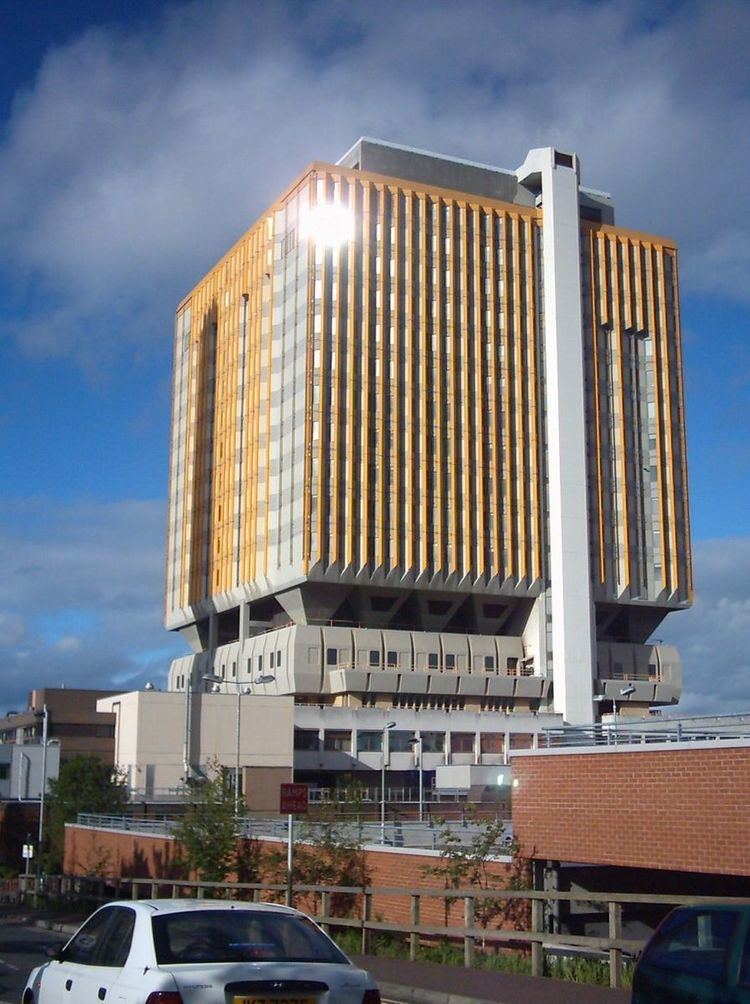Hospital type District General Website Home page Founded 1841 Province Ulster | Emergency department No, A&E Closed 2011 Phone +44 28 9032 9241 Number of beds 900 | |
 | ||
Care system Health and Social Care in Northern Ireland Affiliated university Queen's University of BelfastUlster University Address Lisburn Rd, Belfast BT9 7AB, UK Hours Open today · Open 24 hoursThursdayOpen 24 hoursFridayOpen 24 hoursSaturdayOpen 24 hoursSundayOpen 24 hoursMondayOpen 24 hoursTuesdayOpen 24 hoursWednesdayOpen 24 hours Similar Royal Victoria Hospital, Mater Infirmorum Hospital, Musgrave Park Hospital, Royal Belfast Hospital f, City Hospital railway st | ||
The Belfast City Hospital (Irish: Ospidéal Chathair Bhéal Feirste) located in Belfast, Northern Ireland, is a 900-bed modern university teaching hospital providing local acute services and key regional specialities. Its distinctive tower block dominates the Belfast skyline being the third tallest storeyed building in Ireland (after Windsor House and Obel Tower, both in Belfast). It has a focus on the development of regional cancer and renal services. It is the largest general hospital in the United Kingdom.
Contents
- Belfast city hospital protest
- Origins
- Workhouse Infirmary
- Dr Thomas Andrews
- Fever Hospital
- Infirmary buildings
- Current hospital
- References
Belfast city hospital protest
Origins
The City Hospital began life as a workhouse on the Lisburn Road in the early part of the 19th century.
The Belfast Board of Guardians was started on 11 May 1841 and from the beginning provided sick beds for the poor who did not have access to healthcare services provided by the government.
Workhouse Infirmary
Because it became difficult to separate the sick from the destitute, the Workhouse was developed into a Workhouse Infirmary, which soon had over 600 beds. The largest number of patients in the Belfast Union Infirmary was recorded as 4,252 on 31 January 1869.
Dr. Thomas Andrews
Dr. Thomas Andrews, who qualified as a doctor in Edinburgh in 1835, was appointed by the Guardians at the age of 26 to work with the growing patient population and paid him £60 per annum. Belfast grew to a city of 350,000 people in Victorian times but the city had a problem with poor housing and sewage which led to at least four Cholera outbreaks. In 1847 the first Fever Hospital was opened by the Board of Guardians which was enlarged to 600 beds.
Fever Hospital
In 1849 all fever patients were removed from the wards of the Frederick Street Hospital and transferred to the Infirmary or Fever Hospital on the grounds of the current City Hospital. This decision meant reduced bed numbers in the main Belfast General Hospital but that the amount of surgery now done there increased. In addition to the "fever" patients, the Infirmary also agreed to take all patients with burns, and those with incurable illnesses to the point where they were as many as 1,338 patients in 1883.
The Fever Hospital treated outbreaks of cholera, smallpox, tuberculosis, measles, diphtheria, typhoid, scarlet fever and rabies. The number of nurses grew over these years although they were often untrained. In 1867, there were fifteen paid nurses. In November 1884, Miss Ella Pirrie was appointed Superintendent and Head Nurse. She knew Florence Nightingale and in December 1884, Miss Nightingale sent a Christmas present to Miss Pirrie for the children in the Infirmary. Shortly after she was appointed, the Guardians approved a uniform for the paid nurses, and a distinctive apron for the unpaid female attendants. Under Miss Pirrie, nursing training began for the first time in Belfast and the first person, Miss Craig was sent to Dublin to sit a nursing examination. Nurse Craig was appointed Superintendent in 1892.
Infirmary buildings
The Infirmary buildings were designed by Mr. Lanyon. The wards held up to seventy beds but were so large that they were hard to heat. The Maternity Hospital was first established on the City hospital site by Dr. McLeish.
The National Health Service was created in 1948, and three of the Hospital's Laboratory Assistants were among the last 45 of the Workhouse Residents to serve on the hospital staff. Having been orphaned and with no record of their parents, they were known as Pauper John, Skipper and Red Hand Rufus.
Current hospital
The current hospital with its distinctive yellow tower block was opened in 1986. It is 15 storeys and 76 m (250 ft) in height. It is located on a 32-acre (130,000 m2) campus. The Hospital is known internationally for its cancer research programme. This has led to the establishment of a transatlantic partnership between the City Hospital and the National Cancer Institute of the United States.
17 March 2006 saw the opening of an Oncology Centre.
It has four wards with a total of 72 beds. Much of the outpatient chemotherapy takes place in the Bridgewater Suite in main tower block.
